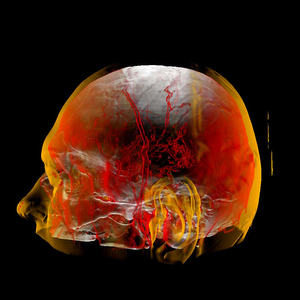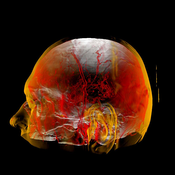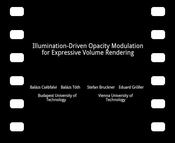Information
- Publication Type: Conference Paper
- Workgroup(s)/Project(s):
- Date: November 2012
- Location: Magdeburg, Germany
- Lecturer: Balázs Csébfalvi
- Booktitle: Proceedings of Vision, Modeling & Visualization 2012
- Conference date: 12. November 2012 – 14. November 2012
- Pages: 103 – 109
- Keywords: illustrative visualization, illumination, volume rendering
Abstract
Using classical volume visualization, typically a couple of isosurface layers are rendered semi-transparently to show the internal structures contained in the data. However, the opacity transfer function is often difficult to specify such that all the isosurfaces are of high contrast and sufficiently perceivable. In this paper, we propose a volumerendering technique which ensures that the different layers contribute to fairly different regions of the image space. Since the overlapping between the effected regions is reduced, an outer translucent isosurface does not decrease significantly the contrast of a partially hidden inner isosurface. Therefore, the layers of the data become visually well separated. Traditional transfer functions assign color and opacity values to the voxels depending on the density and the gradient. In contrast, we assign also different illumination directions to different materials, and modulate the opacities view-dependently based on the surface normals and the directions of the light sources, which are fixed to the viewing angle. We will demonstrate that this model allows an expressive visualization of volumetric data.Additional Files and Images
Additional images and videos
Additional files
 Paper:
Illumination-driven opacity modulation in direct volume rendering
Paper:
Illumination-driven opacity modulation in direct volume rendering
Weblinks
No further information available.BibTeX
@inproceedings{Csebfalvi-2012-IOM,
title = "Illumination-Driven Opacity Modulation for Expressive Volume
Rendering",
author = "Bal\'{a}zs Cs\'{e}bfalvi and Bal\'{a}zs T\'{o}th and Stefan
Bruckner and Eduard Gr\"{o}ller",
year = "2012",
abstract = "Using classical volume visualization, typically a couple of
isosurface layers are rendered semi-transparently to show
the internal structures contained in the data. However, the
opacity transfer function is often difficult to specify such
that all the isosurfaces are of high contrast and
sufficiently perceivable. In this paper, we propose a
volumerendering technique which ensures that the different
layers contribute to fairly different regions of the image
space. Since the overlapping between the effected regions is
reduced, an outer translucent isosurface does not decrease
significantly the contrast of a partially hidden inner
isosurface. Therefore, the layers of the data become
visually well separated. Traditional transfer functions
assign color and opacity values to the voxels depending on
the density and the gradient. In contrast, we assign also
different illumination directions to different materials,
and modulate the opacities view-dependently based on the
surface normals and the directions of the light sources,
which are fixed to the viewing angle. We will demonstrate
that this model allows an expressive visualization of
volumetric data.",
month = nov,
location = "Magdeburg, Germany",
booktitle = "Proceedings of Vision, Modeling & Visualization 2012",
pages = "103--109",
keywords = "illustrative visualization, illumination, volume rendering",
URL = "https://www.cg.tuwien.ac.at/research/publications/2012/Csebfalvi-2012-IOM/",
}


 Paper
Paper
